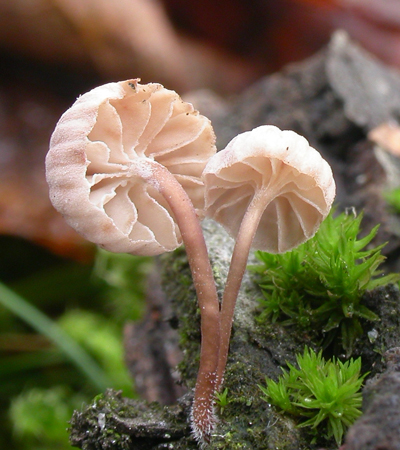On (usually moss-covered) bark of various
living deciduous trees. Autumn to winter. Widespread but apparently not very common. In Norway most records are from southern parts, but recorded north to Nordland.
Pileus 2.5-7(-10)
mm across, hemispherical, parabolical to convex,
often somewhat flattened or depressed centrally, sulcate, translucent-striate, pruinose, vinaceous red, brownish pink, dark
violet, pale brown with a lilaceous tinge, turning more
brownish at age. Lamellae 6-14 reaching the stipe, broad, the edge convex, ascending
to subhorizontal, adnate, more or less decurrent with a
short tooth, at first concolorous with the pileus, pallescent,
turning whitish, finally more or less sepia grey-brown,
the edge paler. Stipe 4-20 x 0.2-1 mm, curved,
pruinose to white-floccose, glabrescent, becoming shiny,
more or less concolorous with the pileus, the base densely
covered with long, white fibrils. Odour and taste insignificant.
Basidia 26-36 x 10.5-13.5 µm, clavate, 4-spored or 2-spored. Spores
from 4-spored basidia 8-11 x 8-10 µm, from
2-spored basidia up to 14.5 µm, Q 1.0-1.3, Qav ~ 1.1, globose to subglobose,
amyloid. Cheilocystidia
15-40 x 6-14 µm, occurring mixed with basidia, clavates,
covered with unevenly spaced, simple to branched, curved
to tortuous excrescences up to 1-10 x 0.5-1.5 µm. Pleurocystidia absent. Lamellar trama dextrinoid, vinescent in Melzer’s reagent. Hyphae
of the pileipellis 2.5-9 µm wide, covered with warts
or cylindrical excrescences 1.5-12 x 1-1.5 µm. Hyphae of the cortical
layer of the stipe 1-4 µm wide, smooth to diverticulate, excrescences 1-9 x 1-1.5 µm, the terminal
cells (caulocystidia) 30- 80 µm long, usually slender, clavate,
diverticulate. Clamps present in 4-spored form, absent in 2-spored form.
|
M. meliigena and Mycena pseudocorticola
can often be found growing together on
the same trunk. M.
pseudocorticola seems to be more common.
Young, fresh specimens of the two species are not
difficult to separate, but with age they both turn
more brownish and can be hard to identify macroscopically.
Microscopically they are very similar too. Maas Geesteranus
(1982a) pointed at a quite reliable character to tell
them apart in the shape and size of the terminal cells
of the stipe cortex. In M.
pseudocorticola these cells are stubby, not
longer than 37 µm, whereas much longer, more
slender, cells are by far the more common kind in
M. meliigena.
The brown colours in older specimens
may cause confusion with M.
supina, but that species have
cheilocystidia with only short excrescences and smaller spores. M.
juniperina has a pale yellowish
brown pileus and grows on Juniperus communis.
Courtecuisse (1986) introduced a white form of M. meliigena (f. alba).
Go to key
to sect. Supinae.
|

|
|